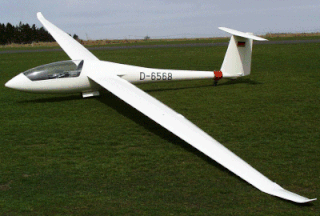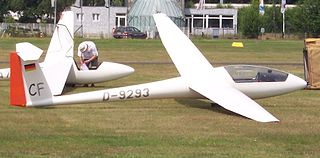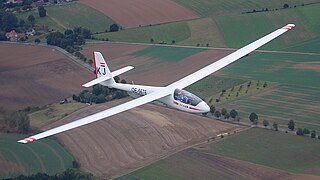
The Schempp-Hirth Discus is a Standard Class glider designed by Schempp-Hirth. It was produced in Germany between 1984 and 1995 but has continued in production in the Czech Republic. It replaced the Standard Cirrus. It was designed by Klaus Holighaus.

The Schempp-Hirth Ventus is a sailplane produced during 1980–1994 by Schempp-Hirth, a German sailplane manufacturer. It was designed by Klaus Holighaus and replaced the Schempp-Hirth Mini-Nimbus. Schempp-Hirth manufactured 613 Ventus sailplanes.

The Rolladen-Schneider LS4 is a Standard Class single seat glider manufactured by Rolladen-Schneider Flugzeugbau GmbH between 1980 and 2003.

The Schempp-Hirth Mini Nimbus is a 15 Metre-class glider designed and built by Schempp-Hirth GmbH in the late 1970s.

The Rolladen-Schneider LS1 is a Standard Class single-seat glider manufactured in Germany by Rolladen-Schneider from 1968 to 1977.

The Schempp-Hirth Janus is a high performance two-seat glider that was built by Schempp-Hirth GmbH. It was the first high-performance two-seater.
The Schempp-Hirth HS-3 Nimbus was a prototype glider built by Klaus Holighaus.

The Schempp-Hirth Nimbus-2 is an Open Class glider built by Schempp-Hirth during the 1970s. The Nimbus-2 first flew in April 1971 and a total of over 240 examples of all subtypes have been built until the beginning of the 1980s. It replaced the Schempp-Hirth Cirrus.

The ASW 28 is a Standard Class glider with a fifteen-metre span built of modern fibre reinforced composites. The manufacturer of the ASW-28 is Alexander Schleicher GmbH & Co. The 'W' indicates this is a design of the influential and prolific German designer Gerhard Waibel. Serial production started in 2000.

The Schleicher ASW 15 is a single-seat sailplane designed in 1968 by Gerhard Waibel and manufactured by Alexander Schleicher GmbH & Co. The ASW 15 has shoulder-mounted wings and an all-flying tailplane, with its single tow-release placement a compromise between winching and aerotowing. The later ASW 15B had several improvements, including a tow-release placed on the plane of symmetry, an 11 cm taller rudder, a slightly larger main wheel, and the provision of a 90-litre water ballast system.

The ASW 22 is an Open Class glider built by Alexander Schleicher GmbH & Co which first flew in 1981. The 'W' in the designation indicates that this is a product of the German designer Gerhard Waibel. An ASW 22 broke the world 750 km triangle speed record in 1985 and ASW 22s have won first place in six World Gliding Championships.

The VSO 10 Vosa is a Standard and Club-Class glider designed and manufactured in the Czechoslovak Republic from December 1978 as a replacement for the VT-116 Orlik II.

The Glasflügel 206 Hornet is a Standard Class sailplane produced in Germany between 1975 and 1979. Of conventional sailplane design with a T-tail, it replaced the Standard Libelle, featuring composite construction throughout. Differences from the earlier aircraft included a redesigned canopy, retractable monowheel landing gear, and provision for 100 kg (220 lbs) of water ballast.

The Grob G104 Speed Astir was a competition sailplane produced in Germany in the late 1970s as Grob's first design in the 15 metre class.

The Standard Austria was a single-seat aerobatic glider that was originally designed and built in Austria from 1959 but production was moved in 1962 to Schempp-Hirth in Germany.

The Slingsby T.59 Kestrel is a British Open class glider which first flew in August 1970. Of fibreglass construction, it features camber-changing flaps, airbrakes, and a retractable main wheel.

The Radab Windex is a family of Swedish high-wing, single-seat aerobatic gliders and motor gliders that was designed by Sven Olof Ridder and produced initially by Radab and later by WindexAir AB as a kit for amateur construction.

The LAK-12 is a Lithuanian mid-wing, single-seat, FAI Open Class glider that was designed and produced by Lietuviškos Aviacinės Konstrukcijos (LAK) in Lithuania and later by Sportine Aviacija and Sport Aviation USSR.
The FVA-20 F. B. Schmetz was a single seat, Standard Class sailplane, built as a one-off aircraft, to explore the application of glass fibre to glider construction. Built over a long period, it finally flew in late 1979.
The Akaflieg Braunschweig SB-7 Nimbus is a Standard class glider designed and built in Germany in the 1960s. It was one of a series of mixed glass fibre and wood designs from the students of Akaflieg Braunschweig.

















